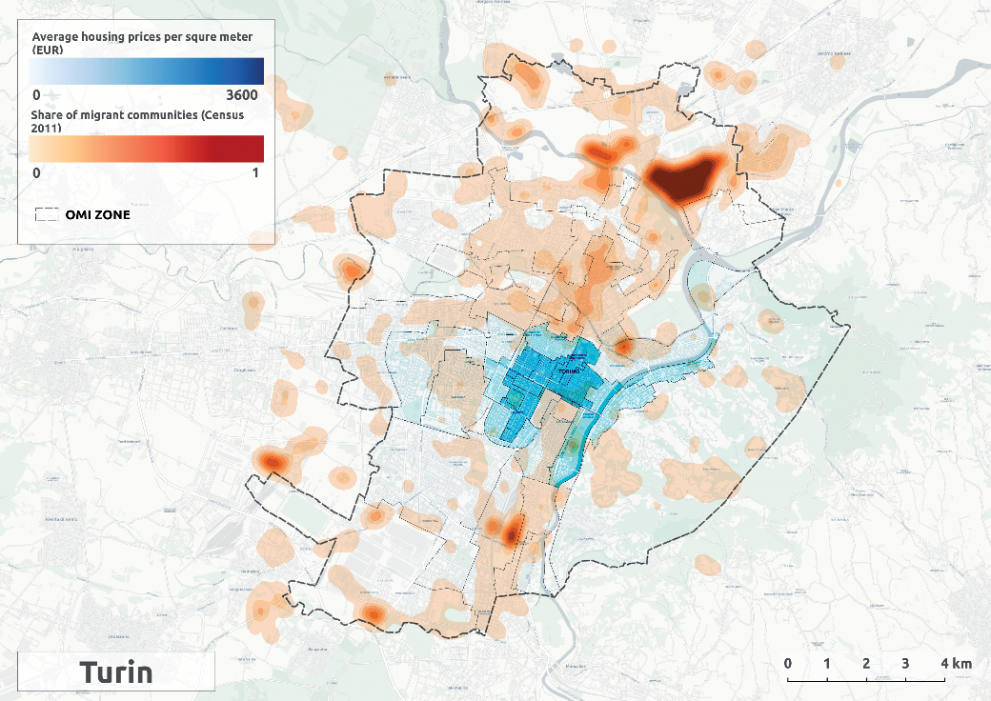
JRC scientists and researchers from across Europe present the final results of the Data for Integration challenge (D4I) at a workshop today in Brussels.
This includes maps showing the extent to which migration is not only limited to big cities, with rural areas and small towns being increasingly characterised by high levels of social and cultural diversity.
Through the challenge, the JRC opened a unique European migration dataset to researchers, with detailed maps covering 45,000 local administrations down to the level of streets and neighbourhoods.
With the ability to delve deeper than nation-level studies, researchers gained several new insights.
Participants explored the impact of migration and diversity on policy relevant issues such as housing markets, the level of segregation within cities, and access to services.
They also explored the possibility that support for anti-immigrant parties might be stronger among those people who live in areas with the lowest concentration of migrants in the community.
The results provide useful information on the diverse communities living in the EU and open new windows of analysis for understanding the local impact of migration across the continent.
Insights such as these also provide policymakers with a better overall picture to develop local policies that help migrants integrate in their host countries.
At the workshop, Professor Ryan D. Enos of Harvard University delivered the keynote address based on his recently published book The Space Between Us. Social Geography and Politics on how urban segregation and diversity shape politics.
The project supports the aims of the Partnership for the Inclusion of Migrants and Refugees, part of the Urban Agenda for the EU.
Over the last few years, cooperation at the local level has increasingly been a priority of the European Commission's work on integration of migrants.
Does migration affect house prices?
A team of researchers from the University of Groningen and the GSSI School for Advanced Studies of L’Aquila presented a study looking at possible relations between the location of asylum seeker reception centres and data on house prices.
Their analysis found a correlation in the Netherlands between the establishment of these centres and house prices becoming lower nearby.
JRC scientists also analysed house prices in Italian provincial capitals alongside the share of migrants living in the city.
They found that the relationship between migration and housing prices is a complex one and, among many factors, it does not just depend on how many people from a migrant background are living in a neighbourhood, but also on their country of origin.
For example, some countries of origin are associated with higher house prices, while ethnically more diverse neighbourhoods are associated with relatively lower house prices.

United in diversity?
It is often assumed that rising migration leads to residential segregation as migrant communities settle in specific neighbourhoods or 'enclaves'.
However, insights from the D4I initiative suggest that this is far from being a systematic pattern.
Researchers from Erasmus University in Rotterdam combined insights on degrees of segregation from the D4I dataset with OECD data on diversity.
They found significant variation between levels of segregation and diversity, with a city's size and location also having an impact on both factors.
The complex relationship between these factors highlights the key role of high resolution data in helping local administrators understand their complex communities when implementing policies to help people integrate.
A study from researchers at the National Technical University of Athens looked at one specific factor that can have an impact on this ability to integrate: access to public transport.
They found that migrants actually tend to reside in areas where access to public transport is relatively easy.
The study paves the way for further research to investigate the extent to which this access is crucial for societal inclusion.
Such research can also provide useful indications to policymakers on where mobility investments are needed.
Does migrant concentration impact electoral outcomes?
With the new level of detail available from the D4I dataset, JRC scientists took a closer look at voting behaviour in specific neighbourhoods and electoral districts.
For example, they found that in the city of Rotterdam during the Dutch elections of 2017, the highest vote shares for the anti-immigrant PVV party came in neighbourhoods with a low concentration of migrants.
These results are shown in the maps below, where votes for the immigrant-based DENK party are also shown.
Their findings suggest that anti-immigrant sentiment depends on a combination of concurrent factors but it appears to be stronger among those people who, in their daily life, are less likely to be in regular contact with people from a migrant background.

Background
The D4I challenge was launched and managed by the JRC's Knowledge Centre on Migration and Demography (KCMD). The KCMD works towards better knowledge management for sound EU policy making.
To strengthen the Commission’s overall response to the opportunities and challenges related to migration, the KCMD aims to be the point of reference to support the work of Commission services and Member States on migration and related issues.
The project supports the aims of the Partnership for the Inclusion of Migrants and Refugees, part of the Urban Agenda for the EU.
Specifically, it supports the Commission's aim to facilitate evidence based migrant integration policies.
The D4I dataset covers 8 countries and 45,000 local administrative units, with a detail down to street level.
JRC scientists generated maps by harmonising and spatially processing official 2011 census statistics collected from national institutes in France, Germany, Ireland, Italy, the Netherlands, Portugal, Spain and the UK.
Related Content
Details
- Publication date
- 27 November 2018
